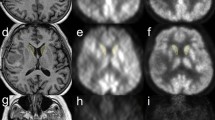Abstract.
Assessment of the exact spatial relation between tumour and adjacent functionally relevant brain areas is a primary tool in the presurgical planning in brain tumour patients. The purpose of this study was to compare a preoperative fluorine-18 fluorodeoxyglucose positron emission tomography ([18F]FDG PET) activation protocol in patients with tumours near the central area with the results of intraoperative direct cortical electrostimulation, and to determine whether non-invasive preoperative PET imaging can provide results equivalent to those achieved with the invasive neurosurgical "gold standard". In this prospective study, we examined 20 patients with various tumours of the central area, performing two PET scans (each 30 min after i.v. injection of 134–341 MBq [18F]FDG) in each patient: (1) a resting baseline scan and (2) an activation scan using a standardised motor task (finger tapping, foot stretching). Following PET/MRI realignment and normalisation to the whole brain counts, parametric images of the activation versus the rest study were calculated and pixels above categorical threshold values were projected to the individual MRI for bimodal assessment of morphology and function (PET/MRI overlay). Intraoperative direct cortical electrostimulation was performed using a Viking IV probe (5 pulses, each of 100 µs) and documented using a dedicated neuro navigation system. Results were compared with the preoperative PET findings. PET revealed significant activation of the contralateral primary motor cortex in 95% (19/20) of the brain tumour patients (hand activation 13/13, foot activation 6/7), showing a mean increase in normalised [18F]FDG uptake of 20.5%±5.2% (hand activation task) and 17.2%±2.5% (foot activation task). Additionally detected activation of the ipsilateral primary motor cortex was interpreted as a metabolic indication for interhemispheric compensational processes. Evaluation of the PET findings by cortical stimulation yielded a 94% sensitivity and a 95% specificity for identification of motor-associated brain areas. In conclusion, the findings indicate that a relatively simple and clinically available [18F]FDG PET activation protocol enables a sufficiently precise assessment of the local relation between the intracranial tumour and the adjacent motor cortex areas and may facilitate the presurgical planning of tumour resection.
Similar content being viewed by others
Author information
Authors and Affiliations
Additional information
Received 25 February and in revised form 20 May 2001
Electronic Publication
Rights and permissions
About this article
Cite this article
Schreckenberger, M., Spetzger, U., Sabri, O. et al. Localisation of motor areas in brain tumour patients: a comparison of preoperative [18F]FDG-PET and intraoperative cortical electrostimulation. Eur J Nucl Med 28, 1394–1403 (2001). https://doi.org/10.1007/s002590100582
Published:
Issue Date:
DOI: https://doi.org/10.1007/s002590100582




